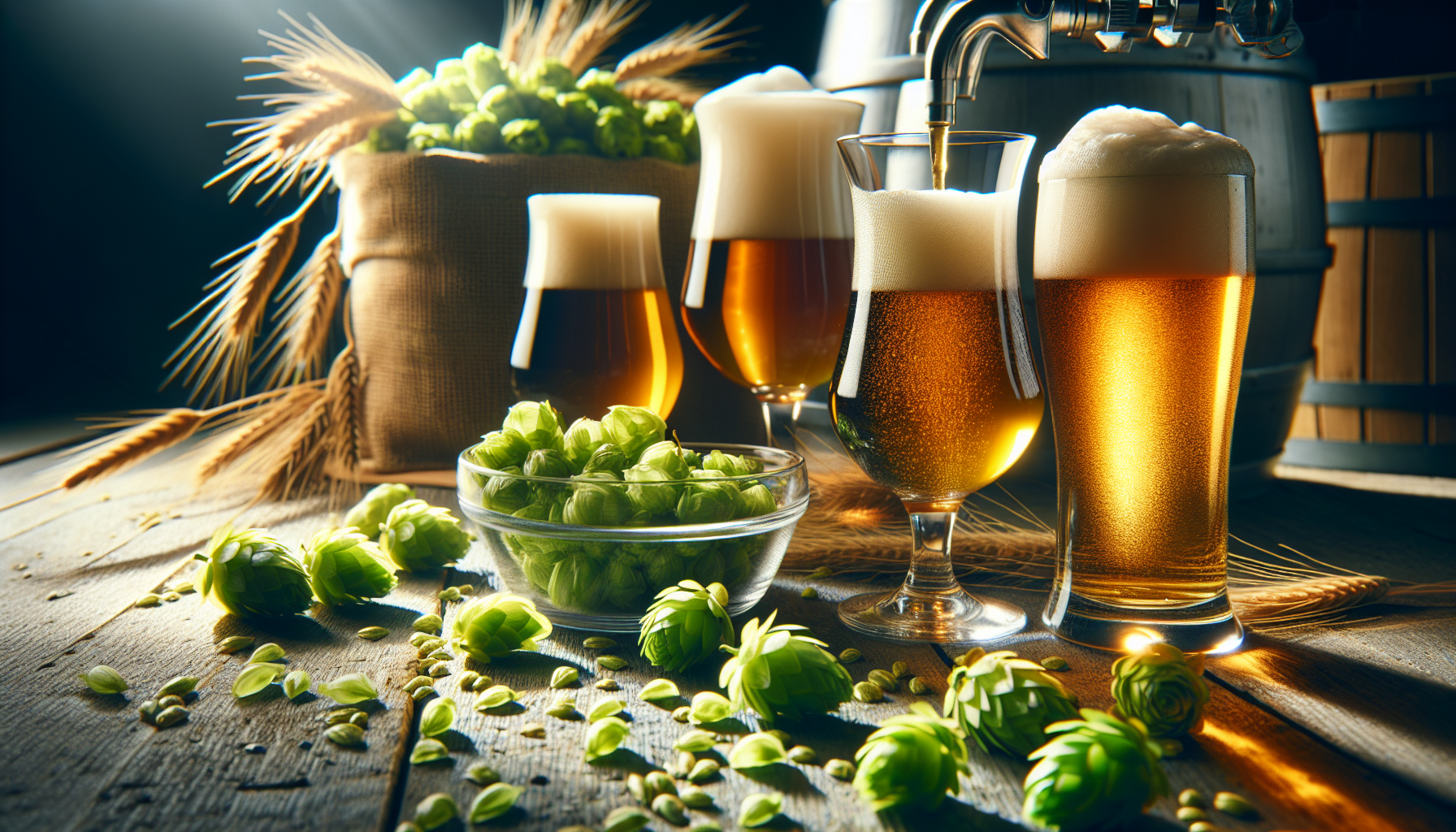Understanding the Beer Tasting Process
Understanding the Beer Tasting Process
Beer tasting is an art. It allows you to savor the complex flavors, aromas, and textures that each beer has to offer. Whether you are a casual beer enthusiast or a serious beer connoisseur, understanding the beer tasting process can greatly enhance your appreciation for this ancient beverage.
The Visual Examination
The first step in beer tasting is to visually examine the beer. Pour the beer into a clean, clear glass and hold it up to the light. Observe the beer’s color, clarity, and carbonation. Different beer styles will have different colors, ranging from pale straw to deep amber or even pitch black. Take note of any haziness or sediment in the beer, as this can indicate issues with filtration or aging. The carbonation level can be judged by the size and persistence of the bubbles.
The Aromatic Evaluation
After visually examining the beer, it’s time to evaluate its aroma. Swirl the beer gently in the glass to release its aromas. Bring the glass close to your nose and take a deep sniff. Note any distinct aromas such as hops, malt, fruits, spices, or even floral notes. The aroma can give you insights into the ingredients used and the brewing process. Experienced tasters can often detect subtle nuances and complexities in the beer’s aroma.
The Flavor Analysis
Now comes the most rewarding part – tasting the beer. Take a small sip and let the flavors coat your palate. Pay attention to the initial taste, the mouthfeel, and the aftertaste. Notice the flavors of malt, hops, yeast, and any other ingredients used. Is the beer bitter, sweet, or balanced? Does it have a lingering bitterness or a smooth finish? Each beer style will have its own unique flavor profile, and understanding these variations is key to becoming a discerning beer taster.
Assessing Mouthfeel
Mouthfeel refers to the texture and body of the beer. Evaluate how the beer feels in your mouth – is it light or full-bodied? Does it have a smooth, creamy texture or a more carbonated, effervescent feel? The mouthfeel can greatly influence your overall enjoyment of the beer and is an important aspect to consider when analyzing its quality.
Comparing and Contrasting
To fully appreciate a beer, it often helps to compare it to others. Try tasting different beers side by side to discern their similarities and differences. Compare the aromas, flavors, and mouthfeel of each beer, and take note of your preferences. This can help you develop a better understanding of your own taste preferences and expand your knowledge of different beer styles.
Keeping a Tasting Journal
Finally, keeping a tasting journal can be a helpful tool in developing your beer tasting skills. Jot down notes about the beers you taste, including their appearance, aroma, flavor, and mouthfeel. This can serve as a reference for future tastings and help you track your beer preferences over time. Additionally, it can be a fun way to reminisce about the beers you have enjoyed and the experiences associated with them.
In conclusion, understanding the beer tasting process is a journey of exploration and appreciation. By taking the time to visually examine the beer, evaluate its aroma, analyze its flavor and mouthfeel, and compare it to others, you can develop a deeper understanding and enjoyment of this beloved beverage. So grab a glass, pour your favorite beer, and embark on a tasting adventure that will open your senses to the wonderful world of beer.
Exploring the Appearance and Aroma of the Beer

Exploring the Appearance and Aroma of Beer
Beer is a fascinating beverage that offers a wide range of flavors, textures, and aromas to explore. When it comes to beer tasting, the appearance and aroma play a significant role in enhancing the overall experience. In this article, we will delve into the captivating world of beer’s appearance and aroma, and how they contribute to the enjoyment of this beloved beverage.
The Appearance of Beer
The first aspect to consider when exploring beer is its appearance. Pouring a beer into a glass allows us to appreciate its color, clarity, and the effervescence of the carbonation. The color of a beer can vary widely, ranging from pale gold and amber to deep brown and even black. Different beer styles have their distinct color profiles, and each hue adds to the visual appeal.
To describe the color of beer accurately, the beer community has established a scale called the “Standard Reference Method” (SRM). This scale ranges from light straw color (low SRM values) to an opaque black (high SRM values). By identifying the SRM level of a beer, you can have a better understanding of its overall appearance even before taking a sip.
Along with color, the clarity of beer also plays a role in its visual appeal. Some beers have a crystal-clear appearance, while others may have a slight haze or cloudiness. The presence of haze can be attributed to the use of certain ingredients, such as wheat or hops, or even the brewing process itself. Unfiltered and unpasteurized beers, like traditional Belgian witbiers or hazy IPAs, showcase a cloudy appearance that adds to their charm.
To fully appreciate beer’s appearance, it’s essential to serve it in the appropriate glassware. Different styles of beer have specific glassware designed to enhance their visual appeal. From tall pilsner glasses to tulip-shaped glasses for Belgian ales, the right glassware can showcase the beer’s color and carbonation, making the experience even more enjoyable.
The Aroma of Beer
Now that we’ve explored beer’s appearance, let’s dive into its aromatic qualities. The aroma of beer is a complex and intriguing aspect that can greatly influence our perception and enjoyment of the beverage. Similar to wine, beer offers a diverse range of aromas, including fruity, spicy, floral, malty, and hoppy notes.
To fully appreciate a beer’s aroma, it’s recommended to swirl the glass gently to release its aromatic compounds. This allows the volatiles to mix with the air, creating a more intense and inviting fragrance. By bringing the glass closer to your nose, you can immerse yourself in the beer’s aroma and begin to identify the various scents.
Different beer styles exhibit distinct aromatic characteristics. For example, hop-forward beers like India Pale Ales (IPAs) often showcase citrusy, piney, or floral aromas, thanks to the hops used during brewing. Malty beers, on the other hand, offer notes of caramel, toffee, or bread-like aromas.
Brewers also experiment with various adjuncts, such as fruits, spices, and herbs, to add an extra layer of complexity to a beer’s aroma. This can result in aromas like banana and clove in German-style wheat beers (hefeweizens) or coffee and chocolate in rich, dark stouts.
The aroma of beer not only enhances the tasting experience but also gives us valuable clues about the beer’s flavor. A beer with a vibrant, enticing aroma is likely to deliver a flavorful and enjoyable drinking experience.
In conclusion, exploring the appearance and aroma of beer is an exciting journey that allows us to fully engage our senses. From appreciating its unique color and clarity to savoring the intricate aromas, beer offers a world of exploration and discovery. So, next time you have a beer in front of you, take a moment to admire its beauty and inhale its enticing aroma before taking that first delightful sip.
Analyzing the Flavor Profile

Understanding the Flavor Profile of Beer
Beer is a complex beverage with a wide range of flavors and aromas. Every beer has its own unique flavor profile, which is determined by various factors such as ingredients, brewing techniques, and fermentation processes. As a beer enthusiast, it is important to develop the ability to analyze and appreciate the different flavors present in beer.
What is a Flavor Profile?
A flavor profile refers to the combination of tastes and aromas that can be detected in a particular beer. It involves identifying the different flavors present, as well as understanding how they interact with each other. The flavor profile of a beer can be described using a variety of terms, such as malty, hoppy, fruity, spicy, or earthy.
Tasting Beer
Tasting beer is not as simple as taking a sip and swallowing. To analyze the flavor profile, it is important to engage all your senses and follow a systematic approach. Here are some steps to help you analyze the flavor profile of a beer:
- Appearance: Observe the color, clarity, and head of the beer. These visual cues can give you an indication of what flavors to expect.
- Aroma: Take a moment to swirl the beer gently in the glass to release its aromas. Breathe in deeply and try to identify any specific scents or aromas. Note whether it is malty, hoppy, fruity, or any other distinct aroma.
- Flavor: Take a small sip of the beer and let it coat your entire palate. Pay attention to the different flavors that emerge. Is it primarily sweet, bitter, or balanced? Do you detect any specific flavors such as caramel, chocolate, citrus, or spices?
- Mouthfeel: Consider the texture and body of the beer. Is it light, medium, or full-bodied? Does it feel smooth, creamy, or effervescent?
- Finish: Pay attention to the aftertaste. Does the flavor linger on your palate? Is it bitter, sweet, or dry?
Developing Your Palate
Developing a discerning palate takes practice and experience. To improve your ability to analyze beer flavors, try tasting different styles of beer and pay attention to the subtle nuances. Take notes on what you notice and compare your observations with others.
Joining beer tasting events or joining a beer club can also provide opportunities to expand your knowledge. Discussing flavors with fellow beer enthusiasts can help you develop a vocabulary to describe different tasting notes accurately.
Analyzing the flavor profile of beer is an art that requires practice and attention to detail. By following a systematic approach, engaging your senses, and continuously exploring different styles of beer, you can develop a greater understanding and appreciation for the various flavors and aromas found in this beloved beverage.
Considering Mouthfeel and Aftertaste

Mouthfeel: The Texture of Beer
When it comes to enjoying a beer, it’s not just about the taste. The mouthfeel of a beer plays a crucial role in enhancing the overall sensory experience. Mouthfeel refers to the tactile sensation and texture of the beer in your mouth. It is determined by factors such as carbonation levels, body, viscosity, and temperature.
Carbonation: The level of carbonation in a beer affects its mouthfeel. Higher carbonation creates a lively and effervescent sensation on the palate, while lower carbonation gives a smoother and more subdued feel.
Body: The body of a beer refers to its thickness or viscosity. Beers can range from light-bodied to full-bodied. Light-bodied beers feel thin and watery, while full-bodied beers have a heavier and more substantial mouthfeel.
Viscosity: Viscosity refers to the beer’s resistance to flow. Beers with higher viscosity tend to have a thicker and more coating mouthfeel, while those with lower viscosity feel lighter and less sticky.
Temperature: The temperature at which a beer is served can greatly impact its mouthfeel. Colder temperatures can numb the taste buds and make the beer feel crisper and more refreshing, while warmer temperatures can enhance the complexity and richness of the flavors, resulting in a fuller mouthfeel.
Aftertaste: The Lingering Flavor
Aftertaste, also known as the finish, is the flavor that remains in your mouth after you’ve swallowed the beer. It can range from short and subtle to long and pronounced. The aftertaste is influenced by several factors, including the beer’s ingredients, brewing process, and aging.
Ingredients: The choice and quality of ingredients, such as malt, hops, yeast, and adjuncts, can greatly impact the aftertaste. Different combinations and proportions of these ingredients can yield flavors ranging from sweet and malty to bitter and hoppy.
Brewing Process: The brewing process, including fermentation and conditioning, plays a significant role in shaping the beer’s aftertaste. Factors such as yeast strains, fermentation temperature, and maturation time can contribute to the development of unique flavors and aromas that linger on the palate.
Aging: Some beers, particularly those of the barrel-aged variety, undergo a maturation process that can intensify and enhance their aftertaste. Aging in wooden barrels can impart additional flavors and complexities, resulting in a more layered and lingering finish.
Pairing Mouthfeel and Aftertaste
When it comes to pairing beer with food, considering mouthfeel and aftertaste can elevate the dining experience. Lighter-bodied beers with crisp carbonation can cleanse the palate and complement delicate flavors, while fuller-bodied beers with a more substantial mouthfeel can stand up to bolder and richer dishes.
Similarly, the aftertaste of a beer can enhance or contrast with certain food flavors. Beers with a lingering bitterness can balance out fatty or greasy foods, while beers with sweeter aftertastes can complement desserts or spicy dishes.
In conclusion, understanding and appreciating the mouthfeel and aftertaste of beer can greatly enhance your enjoyment and exploration of different styles and flavors. So, the next time you raise a glass, take a moment to savor the texture and flavors that linger, and discover a whole new dimension of beer appreciation.





Leave a Reply